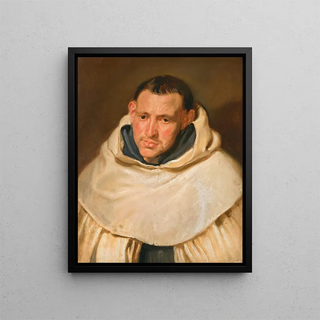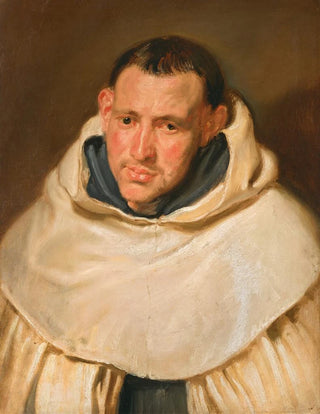Art print | Portrait of a Carmelite monk - Antoine van Dyck


View from behind

Frame (optional)
In the world of Baroque painting, few works manage to capture the essence of humanity with such depth as the "Art print of a Carmelite monk" by Antoine van Dyck. This iconic piece, created in the 17th century, embodies not only the exceptional talent of the artist but also the spirit and concerns of his era. Through delicate nuances of color and the interplay of shadow and light, Van Dyck succeeds in conveying a palpable emotion, inviting the viewer to delve into the intimacy of the depicted character. This portrait, which appears simple at first glance, actually reveals a fascinating complexity, paying homage to the spirituality and contemplative life of Carmelite monks.
Style and uniqueness of the work
Van Dyck's style, characterized by refined elegance and unparalleled technical mastery, is fully expressed in this portrait. The composition is both balanced and dynamic, highlighting the monk in a posture that evokes both serenity and gravity. The details of the clothing, carefully rendered, demonstrate meticulous attention to textures and materials. The colors, subtly chosen, oscillate between warm tones and deep shadows, creating an atmosphere that is both soothing and introspective. The light, gently caressing the monk's face, accentuates his meditative expression, capturing the very essence of his spiritual vocation. This portrait is not limited to a simple representation; it becomes a true dialogue between the artist, the model, and the viewer—a invitation to reflect on the nature of faith and devotion.
The artist and his influence
Antoine van Dyck, a pupil of Rubens, established himself as one of the great masters of portraiture in the 17th century. His influence extends far beyond the borders of his native Belgium, reaching royal courts across Europe. Van Dyck mastered blending realistic features with subtle idealization, creating portraits that transcend mere visual recording. His innovative approach to portraiture paved the way for many artists, who sought

Matte finish

View from behind

Frame (optional)
In the world of Baroque painting, few works manage to capture the essence of humanity with such depth as the "Art print of a Carmelite monk" by Antoine van Dyck. This iconic piece, created in the 17th century, embodies not only the exceptional talent of the artist but also the spirit and concerns of his era. Through delicate nuances of color and the interplay of shadow and light, Van Dyck succeeds in conveying a palpable emotion, inviting the viewer to delve into the intimacy of the depicted character. This portrait, which appears simple at first glance, actually reveals a fascinating complexity, paying homage to the spirituality and contemplative life of Carmelite monks.
Style and uniqueness of the work
Van Dyck's style, characterized by refined elegance and unparalleled technical mastery, is fully expressed in this portrait. The composition is both balanced and dynamic, highlighting the monk in a posture that evokes both serenity and gravity. The details of the clothing, carefully rendered, demonstrate meticulous attention to textures and materials. The colors, subtly chosen, oscillate between warm tones and deep shadows, creating an atmosphere that is both soothing and introspective. The light, gently caressing the monk's face, accentuates his meditative expression, capturing the very essence of his spiritual vocation. This portrait is not limited to a simple representation; it becomes a true dialogue between the artist, the model, and the viewer—a invitation to reflect on the nature of faith and devotion.
The artist and his influence
Antoine van Dyck, a pupil of Rubens, established himself as one of the great masters of portraiture in the 17th century. His influence extends far beyond the borders of his native Belgium, reaching royal courts across Europe. Van Dyck mastered blending realistic features with subtle idealization, creating portraits that transcend mere visual recording. His innovative approach to portraiture paved the way for many artists, who sought






